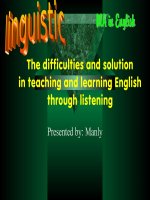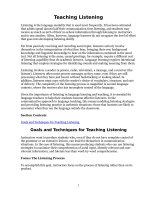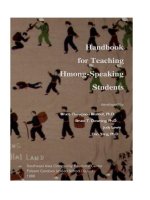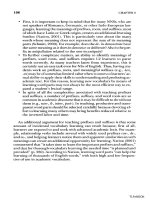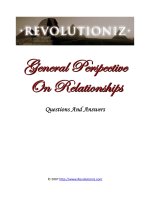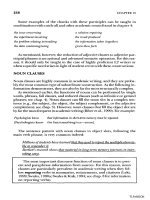TEACHING LISTENING pptx
Bạn đang xem bản rút gọn của tài liệu. Xem và tải ngay bản đầy đủ của tài liệu tại đây (116.18 KB, 12 trang )
TEACHING LISTENING
(Adopted from English Language Teaching Methodology-
BA upgrading course-The Ministry of Education & Training -2003)
1. Open prediction
2. Listen & draw
3. Recall the story
4. Further practice
5. Pre-questions
6. Comprehension
questions
7. Grids
8. Role-play
9. Write –it- up
10.Ordering
11. True/False
statement for
prediction
1. Open prediction
The teacher doesn’t give the students any
statements, only sets the scene and gets
students to predict some of the things they
will hear in the text. Students write down
their predictions. In this way students have
made their own listening guides. The
teacher reads the listening text and students
tick their correct predictions.
2. Listen & draw
The teacher gives students a map, a house plan
or diagram or pictures-any visual that students
can draw on- draw a route, mark changes, or
label parts. The visual can be copied off the
board or given as picture prediction. The
students listen to the text and respond by
drawing, filling in, labeling, numbering, etc….
3. Recall the story
Students re-tell the story in the listening text in
their own words. The teacher can help them by
doing a mini drill first, usually the same
pictures or simplified statements that were
used for ‘predicting’ in the pre-listening task or
‘ordering’ or ‘selecting’ in the while listening
task. Students practice speaking in pairs or
groups. The re-telling with a picture can also
be done as a chain story.
4. Further practice
The teacher chooses a topic related to the
listening topic, usually a topic personalized to
the students, and design a production activity
for the students to do. For example, after doing
the ‘grids’, they will describe other classmates;
or students can recount similar stories to the
listening text-things that have happened to
them personally.
5. Pre-questions
The teacher puts a few pre-questions on the
board: one pre-question for main point in the
listening text. Students read and think about
the pre-questions. The pre-questions focus the
students’ attention but students don’t have to
guess or predict the answers if they don’t want
to. After the first listening they answer the
questions.
6. Comprehension questions
This is the most common ‘while-listening’
technique. Students are given a set of
questions- True/False statements, multiple
choice, and ‘Wh’ or ‘Yes-No’ questions. While
listening, they answer the questions.
Sometimes these comprehension questions
have two parts; the first part help students
focus on the main ideas of the listening.
Multiple choice or True/False items are often
used for this. The second part focuses on the
details- facts, figures etc. ‘Wh’ type questions
are often used for this.
7. Grids
The teacher puts a table on the board and
students copy it. The table gets students to
listen for facts or details in the text. Some of
the information has already been filled in the
boxes of the table to guide their listening.
Students listen and fill in the rest, in note form.
Students work in pairs and compare to check
answers, and the teacher reads the text a
second time or more until everyone agrees on
the answers.
8. Role-play
Students dramatize the listening text, taking
the roles of the characters in the story they
have just heard. This is particularly good for
students who haven’t studied the past tense
but have just heard a story in the past tense.
The role-play transfers a past tense story into
the present tense. The teacher organizes the
role- play by putting all the same ‘roles’
together, eliciting and then letting them practice
what they will say, then cross-grouping so that
each new group has one of each of the
different characters.
9. Write –it- up
Students write up the information that they
have in their listening instruction. They
reconstruct the text in their own words using
the notes in the grids or drawings in the ‘listen
& draw’ exercises as cues. Students practice
writing in groups, pair or individually.
10.Ordering
The teacher gives students statements or
pictures on the board. Students must discuss
in pairs/groups and predict the correct order.
The statements/pictures have letters a,b,c, etc.
Students fill in their chosen order 1, 2, 3, etc. in
a grid. In pairs they compare their answers.
The teacher accepts different orders to create
a ‘disagreement’, so it gives students a real
reason for listening and finding out who is right.
Students listen and tick or correct their order.
11. True/False statement for prediction
The teacher writes 5-10 statements on the board
based on the main ideas in the listening text. Only half
of the statements are true. Students copy the numbers
of statements in their books. In pairs students predict
which of the statements are true and underlines the
numbers (or mark them T/F). Students call out their
predictions. The teacher does not say if they are right
or wrong. The teacher reads the text. Students tick
predictions that are right or wrong and any that they
didn’t guess. In pairs students compare and if there
are disagreements; the teacher reads the text again
until everyone agrees.

